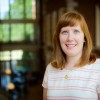This article is more than 5 years old.
Along with Chelcie, I just spent three days in Raleigh at the Northeast Document Conservation Center’s Digital Directions workshop, learning about “best practices and practical strategies for the creation, curation, and use of digital collections” – the quote is from the conference write-up and is spot on.
The conference was a good mix of high-level thinking and nitty-gritty details. I was especially happy to have the opportunity to talk with experts; a challenge with special collections is that our holdings encompass a variety of formats, including artifacts, books, papers, and various forms of audiovisual cassette, reel, and disk. I attended three sessions that discussed various aspects of audiovisual materials handling and vendor management, since these materials types are fragile and the bulk of ours are not yet digitized. As anyone who has used cassette tapes knows, AV materials have unique quirks; since digitization is the only way to preserve that content, vendors are often used to ensure quality products. In another practice-based session, the former Library Fellow for digital Special Collections at NC State University, Jason Evans Groth, described NCSU’s workflow for processing digital materials, which covers files on physical media as well as network file transfers. Archivists are responsible for preserving original records, and digital files are more difficult to keep in original condition than folders from a desk drawer.
The 30,000-foot view sessions covered a variety of topics, including copyright issues for (digital) collections, given by archivist and Berkman Center fellow Peter Hirtle, who has been a leading voice in copyright; selecting collections for digitization; and conducting risk management assessment for digital collections. Greg Colati, who leads UConn’s University Archives, Special Collections and Digital Curation unit, gave a pair of thought-provoking talks about managing digital collections for preservation and access. Those concepts are central to archives work, so I think about them a lot, but digital access and use can be very different from analog counterparts. Chelcie and I were able to have a quick probing discussion with Greg about the LSTA-funded digitization that will be taking off here soon, too, which was useful. On Wednesday afternoon, we wrapped up our Digital Directions experience with a quick visit to see NC State’s digital processing workstation, get a demo of their workflow in action, and meet the library developer who worked with Jason.
All in all, this conference provided a well-timed opportunity for me to think more deeply about how my role as Collections Archivist intersects with digital collections and digital preservation efforts. It would have been valuable had I attended solo, but being able to compare notes with Chelcie and share expertise across the days was an added bonus!

4 Comments on ‘Stephanie at NEDCC Digital Directions’
This sounds like it was a great learning opportunity and I know what you means about the preservation of born-digital materials.
The challenges of archiving multimedia fascinate me! It seems overwhelming! It’s great to know it is being addressed!
It sounds like it was a beneficial conference and you are bringing back good information for future consideration.
Thanks for sharing. Good to hear conference was thought provoking.